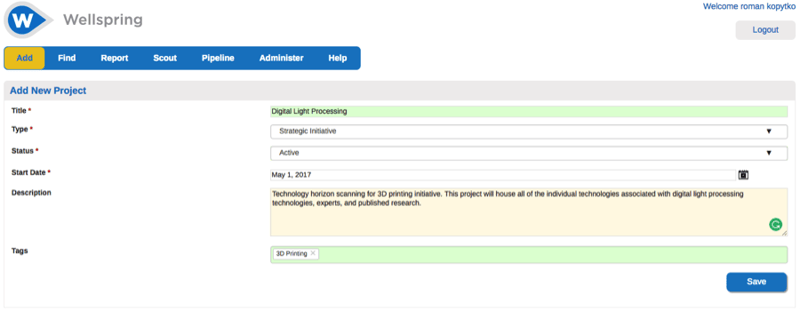Why horizon scanning is valuable
How do organizations monitor a large number of related technologies? How do scouting groups prioritize which technology fields to investigate and which to ignore?
Horizon scanning allows groups to maintain constant awareness of emerging trends, threats, and technology opportunities across a broad spectrum of research fields. This knowledge helps groups adjust R&D priorities and make decisions about which strategic areas of interest technology scouts should investigate. Companies that ignore horizon scanning risk missing the early signs of new technology trends or disruptive innovations. Furthermore, companies that focus only on a few very narrow technology field’s risk missing developments in adjacent disciplines that could impact their broader product development strategy.
What does horizon scanning include
On a basic level, horizon scanning involves two functions: data collection and analysis. The first is the collection of essential information about emerging technologies from a given field of research. Innovation teams use this information to create summaries of each field they examine. These summaries include information about the number of new discoveries, the maturity of technologies, the rate at which new technologies are being discovered, and other key metrics. Teams then repeat these summary exercises across several related areas of research to form a more complete view of a wide range of topics, forming a technology landscape.
The second function of horizon scanning involves the analysis of these technology landscapes in order to understand potential impact and future trends. Teams compare broad areas of research to provide context and help identify areas that could be related to their long-term goals. For example, consider a company that is interested in 3D printing technology. To get an accurate picture of the emerging technologies that could affect their product development plans, the company would investigate dozens of broad technology areas. They may develop technology summaries for immediately related fields like digital light processing, fused deposition modeling, and selective laser sintering. They may also develop technology summaries for adjacent fields like plastics polymers and other advanced materials. The team would collect information about individual inventions within each group, map the key criteria for each group, and compare the results to help them identify trends.
What are the limitations of horizon scanning?
The more fields of adjacent research that an organization can monitor, the better their chances of identifying technology trends early enough to take advantage of them. However, the rate of new scientific discovery and the ever-expanding scope of potentially related research create serious barriers, especially for smaller teams.
To effectively manage a horizon scanning program innovation teams must be able to do three things effectively:
- Quickly find and capture information about individual technologies
- Organize individual technologies into broader groups
- Evaluate and compare these broad groups to find trends
Each one of these tasks comes with a unique set of problems. Searching online journals, patent databases, or university websites is time consuming and requires hours of manual data entry. Storing this data, organizing it in a useful way, and keeping information up to date can be tedious and often difficult work. Finally, gathering consensus about technologies, passing evaluations to subject matter experts, and otherwise sharing the information in a technology landscape can be difficult to scale.
How do organizations manage horizon scanning tasks
Most scouting and innovation teams consist of only a handful of full-time staff. With personal bandwidth limited, it is critical for teams to reduce the time and effort spent on data maintenance and administration. Many small teams wish they had the ability to practice regular technology horizon scanning, but lack the ability to do so effectively.
However, innovation teams around the world are beginning to leverage software tools that act as a force multiplier, allowing them to quickly identify emerging technologies, organize and store data from these discoveries, and easily distill and evaluate broad trends from the data.
Example Horizon Scanning with Wellspring
To illustrate the concept further we have provided a brief example of how a small team could leverage Wellspring software to quickly create a horizon scanning project in a matter of minutes. Note, however, that in real world applications, horizon scanning programs can be as simple or as sophisticated as the team desires.
Step 1. Create Technology Projects
In this example, we will create a technology landscape of the three 3D printing fields mentioned earlier, digital light processing research, fused deposition modeling research, and selective laser sintering research. Our first task is to create a new project for each of these research fields. A project will serve as a container for the individual technologies related to each field. Think of this as a broad strategic area that the team knows they need to investigate. Creating a project allows groups to add and find information related to that broad technology field.

Step 2. Find Individual Technologies
Once the three projects are created, it’s time to fill them with individual opportunities. Wellspring allows users to add information manually if, for example, a scout discovers new technologies at a trade show, or through the system via online database searches. For this example we will use three sources, IEE, USPTO, and Flintbox databases, but Wellspring can connect to any subscription database that the organizations currently use. Users would begin to fill the project records with relevant technologies by searching these databases for keyword, expertise, organization, published date, and other filtering information. Results display automatically de-duplicated and ranked in order of relevance to the query, allowing for users to quickly scan large volumes of data. From here, individual technologies can be added to the correct project record with a single click.
Step 3. Evaluate Technologies
The level of scrutiny applied to each opportunity will vary from company to company, as will the exact criteria being evaluated. Some organizations rely on only basic information for horizon scanning activities, while other conduct through assessments that involve multiple SME evaluations. Wellspring allows users to configure assessment criteria based on their unique needs. In general, a horizon scanning project is meant to capture the basic information about many types of technology. That information can then be distilled into broad trends about emerging fields of research. For these types of projects, it is best to keep assessment forms short and easy to fill out.

Step 4. Automate, Monitor, and Compare
Once the initial assessment criteria for individual technologies has been added to the system teams can begin to combine these individual technologies into a more holistic summary of each field of research. Data flexibility is important in this stage since different metrics may be more or less important depending on the organizational goals. Teams can, for example, compare projects by the number of new publications and the number of new sources of publication to get an idea of how quickly a field is growing. Likewise, teams can focus on market readiness metrics such as average TRL rating or total venture investment dollars to determine how soon a new technology field can be expected to enter early stage products. The options are limitless, but flexibility and reportability is key.
Finally, maintenance can not be overlooked. These horizon scanning projects are only valuable as long as they are up to date. Teams need to automate as much information gathering, data entry, and assessment routing as possible to maintain a useful tool.
To learn more about Wellspring Software click here.




